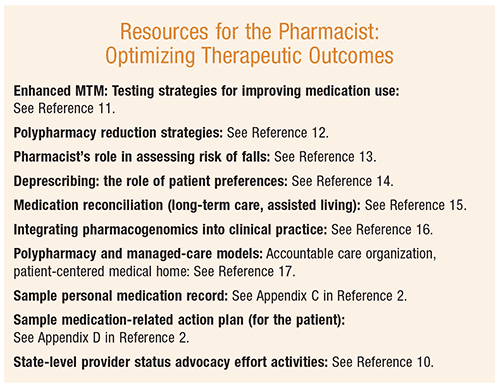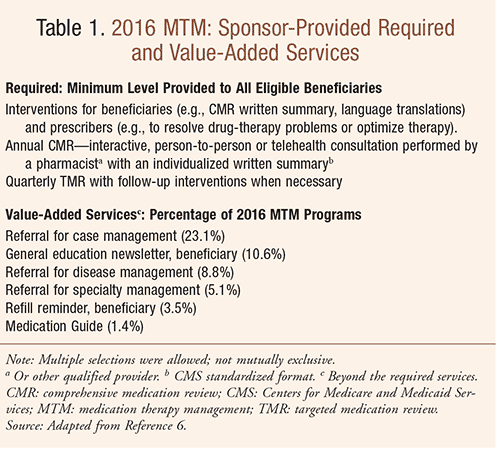It has been more than a decade since congressional staff and national association representatives, including this author, met as part of a Capitol Hill briefing in September 2006 addressing the importance of implementing medication therapy management (MTM) services related to the Medicare Part D legislation.1 Since that time, the momentum surrounding MTM has continued to evolve; this article will focus on highlights of that evolution.
As a distinct service or group of services, MTM aims to optimize therapeutic outcomes for patients and, as designed, is distinct from dispensing services and dispensing-associated counseling. MTM is delivered in a patient-centered manner and is comprehensive in scope.2,3
Historical Context
Put in a contextual timeline, MTM was defined in 2004 based on a consensus by the pharmacy profession.2 Subsequently, a model framework was developed by the American Pharmacists Association (APhA) and the National Association of Chain Drug Stores (NACDS) Foundation. It was published as the Medication Therapy Management in Community Pharmacy Practice: Core Elements of an MTM Service Version 1.0. Further development of this model produced a second version in 2008. It incorporated input from an advisory panel to encompass MTM services involving a variety of practice settings that would embrace the engagement of patients or their caregivers in medication management.2 The goal of this revised APhA/NACDS Foundation document, the Medication Therapy Management in Pharmacy Practice: Core Elements of an MTM Service Model Version 2.0, was to “improve continuity of care and patient outcomes” by achieving a maximum level of “effectiveness and efficiency of MTM service” across a variety of pharmacy practice settings; its adoption was voluntary.2
By 2013, Medicare Part D and an increasing number of other prescription-drug plans (PDPs) covered pharmacist-provided MTM for some of their members.4 Interestingly, only 8% of eligible Medicare Part D patients had a comprehensive medication review (CMR; see TABLE 1). It was also noted that a growing number of pharmacists in the U.S. made a living as consultants by providing in-person or telephone-based MTM.4 As reported in 2014, few health plans cover MTM services because pharmacists lack Medicare provider status (see below).5
Highlights of the 2016 MTM Programs
By May 2016, the Centers for Medicare and Medicaid Services (CMS) noted that there were 623 Part D contracts with an approved MTM program6:
• 495 Medicare Advantage PDPs
• 67 stand-alone PDPs, including employer-contract MTM programs
• 61 Medicare-Medicaid Plans
With regard to eligibility, in 2016, almost 25% of MTM programs used expanded eligibility requirements beyond the minimum requirements specified by the CMS, compared with 24% of programs in 2015.6 Approximately 49% of the programs identify eligible beneficiaries quarterly and more than 28% do this monthly; others identify beneficiaries more frequently (i.e., 13.6% weekly and 9.6% daily). In 2016, the top targeted diseases remained constant: diabetes, chronic heart failure, dyslipidemia, and hypertension.
Even though all programs offer CMRs via the telephone, the percentage of programs offering face-to-face CMRs (75%) and telehealth CMRs had significantly increased by 2016, and the percentage of programs providing alternative language translations had more than doubled from 2015.6 All programs use pharmacists to provide MTM services, and an increasing percentage of programs have contracted with outside vendors; pharmacy interns under direct pharmacist supervision are also providing these services. Data on the type of value-added services being provided are also available for 2016 (TABLE 1).
The annual cost threshold for 2016 ($3,507) was >11% higher than in 2015 ($3,138).6 For proposed changes in the payment methodology for 2018 for Part D and annual adjustments for 2018 to the Medicare Part D benefit parameters for the defined standard benefit, see Reference 7.
Enhanced MTM: Call for Innovation
As an opportunity for stand-alone basic PDPs to offer innovative MTM programs, the Part D Enhanced Medication Therapy Management (Enhanced MTM) model was developed. The CMS indicates that objectives for this model are for these sponsors to learn how to “right-size” their investment in MTM services.8 Additionally, they should be identifying and implementing innovative strategies to8:
• Optimize medication use
• Improve care coordination
• Strengthen healthcare system linkages
At this time, this opportunity is offered in only six selected regions (see Reference 8). For further discussion on Enhanced MTM, and for innovative strategies, tips, and programs for reducing polypharmacy and improving patient outcomes, see Resources.

Moving Forward
Why are pharmacist-provided MTM services needed now more than ever? In spite of technology and the public’s broad and expanding access to drug and disease information on the Internet, there is a demand for the interpretation and application of this information; connecting the uniqueness of a pharmacist’s core strengths and capabilities with that demand is imperative, particularly with respect to the present healthcare dynamics.9 Pharmacists need innovation in order to create pharmacy practice opportunities to reach and better serve the gowing older adult population in an expanding global healthcare marketplace.9
Provider Status for Pharmacists
Provider status, or the recognition of pharmacists’ services as a covered benefit under Medicare Part B at the federal level, would designate pharmacists as providers in addition to establishing a mechanism for payment for their services.10 Pharmacy associations are focusing on advancing provider-status legislation at the federal level (HR4190) and also at state levels.10 According to Weaver, although pharmacists can be recognized by state law as providers (and are in 37 states), the designation is not connected to coverage for services that could be achieved with successful passage of HR4190. For a thorough discussion on state-level provider status advocacy efforts, see Resources.
Conclusion
Healthcare practitioners, pharmacy associations, policymakers, and other stakeholders and organizations that support pharmacist provider status understand that its impact will dovetail with the CMS’s desire to achieve better alignment of PDP sponsor and government financial interests. Additionally, with the unique and exceptional skill set of pharmacists, Enhanced MTM will be better situated to create incentives for investment and development of innovative MTM interventions. The CMS has expressed the goal quite succinctly; it is a focus on “better care, smarter spending, healthier people.”8
REFERENCES
1. Capitol Hill briefing regarding the implementation of Medication Therapy Management (MTM) Services related to the Medicare Part D legislation. Conducted by the American Society of Consultant Pharmacists (ASCP) and the Medicare Rights Center (MRC); sponsored by the office of Congressman Marion Berry, Washington DC. September 15, 2006.
2. American Pharmacists Association and National Association of Chain Drug Stores Foundation. Medication Therapy Management in Pharmacy Practice: Core Elements of an MTM Service Model Version 2.0. Washington, DC: American Pharmacists Association; March 2008. www.pharmacist.com/sites/default/files/files/core_elements_of_an_mtm_practice.pdf. Accessed April 30, 2017.
3. Bluml BM. Definition of medication therapy management: development of professionwide consensus. J Am Pharm Assoc. 2005;45(5):566-572.
4. Collins S. Telephone provides unique entry into the lives of out-of-reach patients. Pharmacy Today. 2013;19(7);34-36. www.pharmacist.com/telephone-provides-unique-entry-lives-out-reach-patients. Accessed April 30, 2017.
5. Collins S. Few health plans cover MTM services because pharmacists lack Medicare provider status. Pharmacy Today. 2014;20(2);68. www.pharmacist.com/few-health-plans-cover-mtm-services-because-pharmacists-lack-medicare-provider-status. Accessed April 30, 2017.
6. Centers for Medicare and Medicaid Services. Fact sheet: summary of 2016 MTM programs. May 4, 2016. www.cms.gov/Medicare/Prescription-Drug-Coverage/PrescriptionDrugCovContra/Downloads/CY2016-MTM-Fact-Sheet.pdf. Accessed April 30, 2017.
7. Centers for Medicare and Medicaid Services. Advance notice of methodological changes for calendar year 2018 for Medicare Advantage capitation rates, Part C and Part D payment policies and 2018 call letter. February 1, 2017. www.cms.gov/medicare/health-plans/medicareadvtgspecratestats/downloads/advance2018.pdf. Accessed May 1, 2017.
8. Centers for Medicare and Medicaid Services. Part D enhanced medication therapy management model. Updated February 13, 2017. https://innovation.cms.gov/initiatives/enhancedmtm/. Accessed May 1, 2017.
9. Zagaria ME. Innovation: the promise of financial viability for pharmacy practice opportunities [Invited editorial]. J Pharm Pract Res. 2015;45(3):259-260.
10. Weaver K. Provider status in the states. PharmacyTimes.com. December 9, 2014. www.pharmacytimes.com/publications/directions-in-pharmacy/2014/december2014/provider-status-in-the-states. Accessed April 30, 2017.
11. Brandt NJ, Cooke CE. Centers for Medicare and Medicaid Services support for medication therapy management (enhanced medication therapy management): testing strategies for improving medication use among beneficiaries enrolled in Medicare Part D. Clin Geriatr Med. 2017;33(2):153-164.
12. Levy HB. Polypharmacy reduction strategies: tips on incorporating American Geriatrics Society Beers and Screening Tool of Older People’s Prescriptions Criteria. Clin Geriatr Med. 2017;33(2):177-187.
13. Fritsch MA, Shelton PS. Geriatric polypharmacy: pharmacist as key facilitator in assessing for falls risk. Clin Geriatr Med. 2017;33(2):205-223.
14. Holmes HM, Todd A. The role of patient preferences in deprescribing. Clin Geriatr Med. 2017;33(2):165-175.
15. Gooen LG. Medication reconciliation in long-term care and assisted living facilities: opportunity for pharmacists to minimize risks associated with transitions of care. Clin Geriatr Med. 2017;33(2):225-239.
16. Bain KT, Knowlton CH, Turgeon J. Medication risk mitigation: coordinating and collaborating with health care systems, universities, and researchers to facilitate the design and execution of practice-based research. Clin Geriatr Med. 2017;33(2):257-281.
17. Stefanacci RG, Khan T. Can managed care manage polypharmacy? Clin Geriatr Med. 2017;33(2):241-255.
To comment on this article, contact rdavidson@uspharmacist.com.







